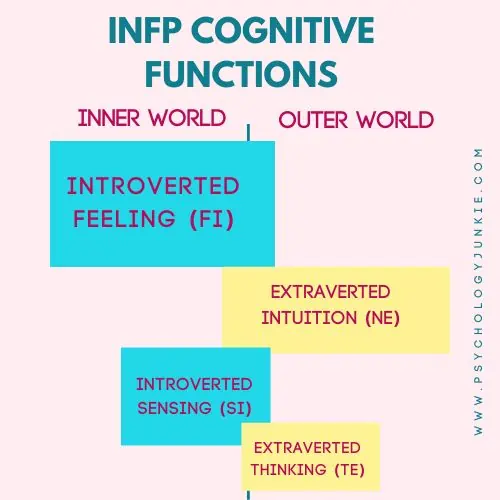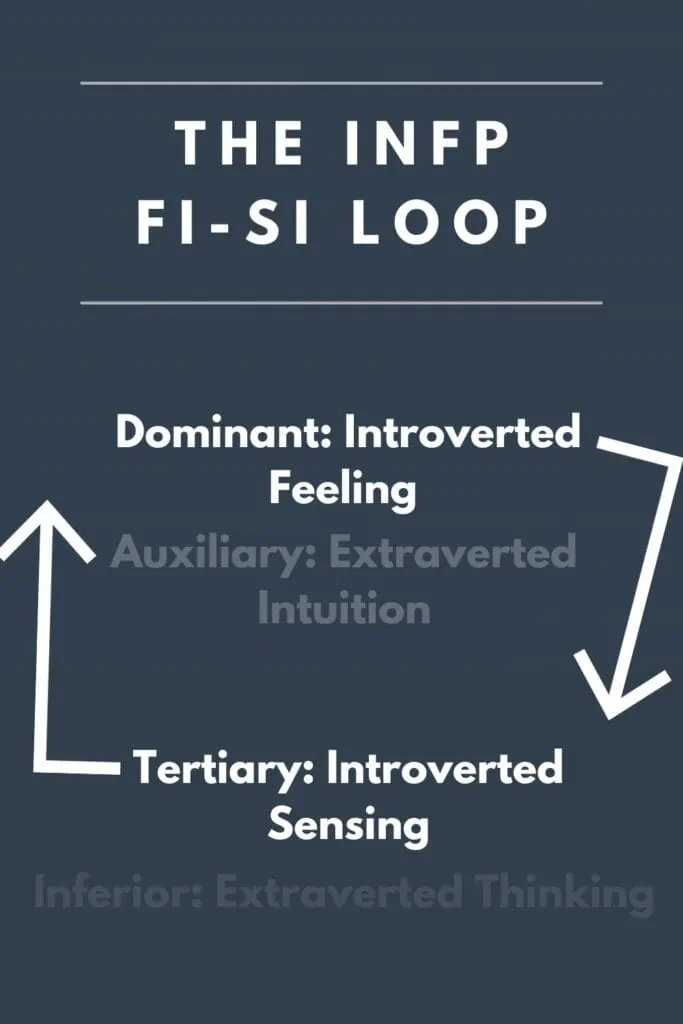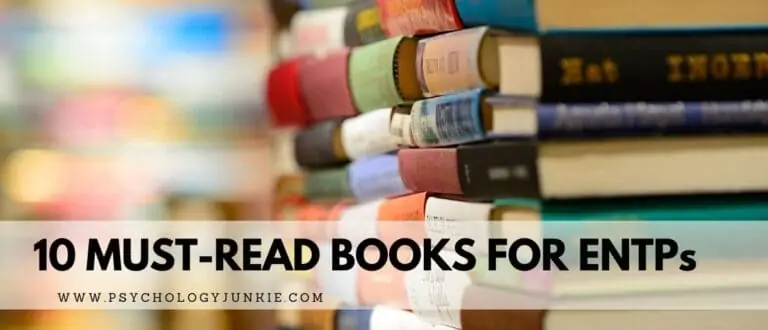The INFP Fi-Si Loop: What It Is and How to Cope
As an INFP, do you ever find yourself stuck in a rut? Do you ruminate about past mistakes or get stuck in your feelings, unable to find a way out? If you relate to this, you may be stuck in what’s called a Fi-Si loop. In the world of personality types, looping refers to the phenomenon where individuals oscillate between their dominant and tertiary functions in their mental function stack. Let’s dive deeper!
Not sure what your personality type is? Take our in-depth personality questionnaire here. Or you can take the official MBTI® here.

But what’s a cognitive function stack?
A cognitive function stack, in essence, is a hierarchy of mental preferences. Think of it as a toolbox in your mind. This toolbox is defined by your Myers-Briggs personality type, in this case, the INFP. As an INFP, your function stack has a unique mix of four different cognitive functions – for INFPs, these functions include Introverted Feeling (Fi), Extraverted Intuition (Ne), Introverted Sensing (Si), and Extraverted Thinking (Te).

You have two introverted and two extroverted functions. If you’ve ever felt slightly ambiverted, that’s because you truly are. Everyone has both introverted and extroverted functions; this keeps human beings balanced and ensures that we can maintain a sense of what’s real in the outer world and what matters inside us.
The order of your cognitive functions determines your approach to processing information, making decisions, and interacting with the world. Imagine the functions as tools that a carpenter reaches for depending on the tasks at hand. Similarly, we subconsciously lean on different cognitive functions based on the situations we encounter. Understanding this toolbox is a key to personal growth, promoting the development of often neglected areas of our personality.
A Deeper Look at the INFP’s Cognitive Functions
The INFP has four primary cognitive functions. Let’s take a look at how they work:
Starting with Introverted Feeling (Fi), the dominant function of the INFP. Here we see a deeply personal inner value system that is highly individualized and unaffected by societal pressures. Thanks to dominant Introverted Feeling, INFPs are guided by their deeply rooted values and beliefs. They have a knack for standing up for what they believe in or feel, even if it goes against popular opinion.
Next is Extraverted Intuition (Ne), the auxiliary function. This feature fuels the INFP’s natural curiosity and creativity. It’s all about exploring patterns, possibilities, and connections. Thanks to Extraverted Intuition, INFPs are often the ones to think outside the box during brainstorming sessions, effortlessly connecting disparate ideas into a cohesive whole.
The tertiary function, Introverted Sensing (Si), is responsible for the INFP’s propensity to reflect on past experiences and imbue personal meaning onto physical objects or experiences.
Lastly, Extraverted Thinking (Te), the inferior function, focuses on organization or efficiency. An INFP may use this function when they need to make a decision based on logical analysis. Because this is the inferior function for the INFP it can be a little harder for them to tap into than the other three above. They may feel more uncertain in this area. This uncertainty can show up like struggling to give objective criticism or struggling to organize tasks in a systematic way to achieve a goal.
This is only the tip of the iceberg, but understanding these cognitive functions can help you as an INFP to be aware of when you’re flowing from one place to another in your function stack.
But What is the Fi-Si Loop?

The Fi-Si Loop, also known as the Introverted Loop for INFPs, is a common phenomenon that occurs when an INFP bypasses their auxiliary function, Extraverted Intuition (Ne), and instead oscillates between their dominant and tertiary functions, Introverted Feeling (Fi) and Introverted Sensing (Si).
Why does the Fi-Si Loop happen?
We all have a preference for the introverted or extroverted world. If you’re an introverted personality type, you’ll feel a temptation to stay in the energy of your introverted functions. If you’re an extroverted personality type, you’ll feel a temptation to stay in the energy of your extroverted functions. It’s more comfortable and familiar to stay in these places because they give you energy.
However, while this might provide temporary solace, being stuck in the Fi-Si loop for prolonged periods can hinder your personal growth and limit your ability to adapt to new situations or ideas.
Understanding and recognizing the occurrence of the Fi-Si loop is a critical step in your journey as an INFP towards self-awareness and personal growth. By acknowledging this loop, you can actively work on breaking free from it, thereby promoting a healthier interaction with your cognitive functions and fostering a more balanced approach to life.
How do INFPs Feel When They’re in a Loop?

When an INFP falls into an Fi-Si loop, they become overly introspective and self-isolating, consumed by an internal world teeming with feelings and memories. Their focus hones in on their emotional state, causing them to ruminate and hyper-fixate on their feelings and past experiences. They can become stuck in revisiting past events, trying to re-live or dissect them, often focusing on their mistakes, or what they could have done differently, which can lead to feelings of regret or guilt.
Additionally, the once vibrant world of possibilities that Extraverted Intuition (Ne) used to paint becomes dim as they bypass this function. The world outside appears overwhelmingly complex and unpredictable, fostering a sense of pessimism about their surroundings. The INFP may retreat further into themselves, withdrawing from social contact, and they may start to neglect their physical needs.
The Fi-Si loop can be a daunting situation, leading to a negative cycle of self-doubt and self-criticism, further feeding the loop. But understanding it is the first step towards breaking free and restoring balance. In the following section, we’ll explore practical strategies to cope with and exit this loop.
Signs that an INFP is in a Fi-Si Loop:
- They get stuck in their comfort zone and won’t tolerate challenges or critiques of their ideas or feelings
- They retreat from the outside world extensively
- They develop tunnel-vision and lose the ability to imagine other perspectives
- They become hooked on creature comforts and specific rituals
- They shut out new experiences
- They hide their true nature from others
- They ruminate over negative past experiences (or idealize them)
- They become unwilling to examine their values or beliefs against any objective criteria
- They become defensive and bitter when someone challenges them
- They are excessively risk-averse
How to Get Out of a Loop
The solution? Give your extroverted functions a chance to breathe, starting with Extraverted Intuition. INFPs may need to force themselves into new experiences, big or small. This can help broaden their perspective and unlock new possibilities that Extraverted Intuition (Ne) offers. Alternatively, engaging in creative activities like painting, writing, or music can also help INFPs tap into their Extraverted Intuition (Ne) and break free from the Fi-Si loop.
When INFPs get in touch with their Extraverted Intuition, they become more open-minded, creative, imaginative, and connected to the world around them. They become less staunch in their opinions and more exploratory; discovering new ways of seeing things and testing their ideas and feelings against real-world experiences and feedback.
Ways to Get In Touch with Extraverted Intuition:
- Explore New Environments: Visiting new places or simply changing up your daily routine can stir up your Extraverted Intuition. The unfamiliarity promotes exploration, curiosity, and innovative thinking.
- Partake in Ideation Sessions: Participate in brainstorming sessions or mind mapping exercises. This will stimulate your Ne as you connect disparate ideas to form a cohesive whole.
- Engage in Artistic Activities: Drawing, painting, writing, or any form of artistic expression can stimulate your intuition as it promotes the exploration of novel ideas and new perspectives.
- Delve into Reading and Learning: Stimulate your intuition by immersing yourself in a variety of topics. The diversity of ideas and perspectives will spark your curiosity and creativity.
- Practice Improvisation: Whether in speech, theatrical performance, or music, improvisation requires quick thinking and adaptation, both hallmarks of Ne.
- Mindfulness and Observation: Take time to observe your surroundings and be present in the moment. This active engagement can stimulate your extroverted functions and cultivate a broader perspective.
What Are Your Thoughts?
We hope this in-depth analysis has provided you with a better understanding of the Fi-Si loop in INFPs and ways to navigate it. However, experiences may vary and everyone has their unique ways of approaching personal growth and self-improvement. Do you have experiences or insights to share about the Fi-Si loop? What strategies have worked for you? Please let us know in the comments section below. Your thoughts and experiences can be a great source of inspiration and motivation for others in the same boat.
Find out more about your personality type in our eBooks, Discovering You: Unlocking the Power of Personality Type, The INFJ – Understanding the Mystic, The INTJ – Understanding the Strategist, and The INFP – Understanding the Dreamer. You can also connect with me via Facebook, Instagram, or Twitter!
Other Articles You Might Enjoy:
The INFP Cognitive Functions In-Depth
How to Communicate Effectively with an INFP
References:
Personality Hacker: Harness the power of your personality type to transform your work, relationships and life by Joel Mark Witt and Antonia Dodge (Ulysses Press, 2018)
Understanding Yourself and Others® An Introduction to the Personality Type Code by Linda V. Berens and Dario Nardi (Interstrength, 2004)







